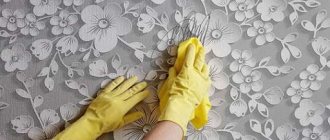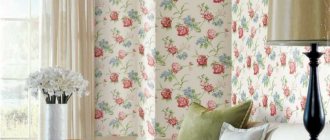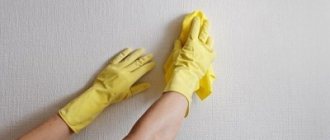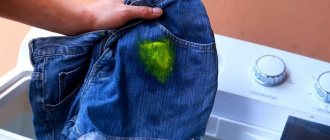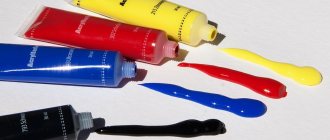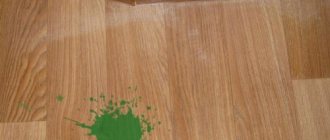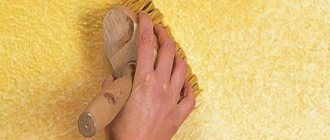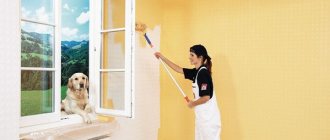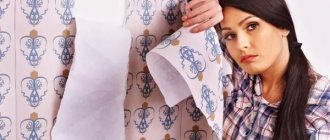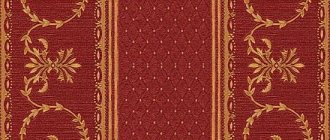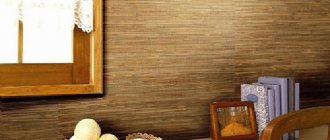How to remove grease stains from wallpaper
Grease stains are a problem in every dining room or kitchen. During cooking and eating, no matter how careful the residents of the house are, annoying greasy blots appear on the walls, which spoil the room.
The easiest way to remove stains is from vinyl-based or non-woven coatings. Their structure prevents liquid substances from penetrating deep into the paper layer. And the water-repellent effect allows you to wash the coating with plain water with the addition of various soaps. It is more difficult to remove stains on paper coverings and in this case you need to act more carefully. There are several ways to get rid of greasy stains on wallpaper:
- Remove stains from wallpaper with chalk. Grind a little chalk into powder. Rub this powder into the stain and leave for a while. Fat is absorbed into the chalk and removed along with it. To speed up the process, chalk is placed in a cotton cloth or napkin, applied to the stain and ironed.
- How to remove a stain with starch. The starch is diluted with water until a thick mixture is formed. Then this mixture is applied to the oily area in a thick layer and left for one night. The next day, the starch mixture is removed with a brush, and the stain goes away with it.
- Remove the stain with baking soda. Another option to remove greasy stains on wallpaper is baking soda. Mix ¼ cup of baking soda with water to a gel consistency. Apply this mixture to a soft cloth and wipe off the stain. The remaining mixture is removed with a soft and dry cloth.
- Remove grease stains with bread. Cut out a piece of bread the same size as the stain itself. Press it to the surface of the wallpaper and hold it for several seconds. This action is repeated until the stain disappears. A piece of bread is replaced with a fresh one every time.
- Remove grease stains from wallpaper using an iron and toilet paper. This method is especially effective if the stain is fresh. Toilet paper or a paper napkin is applied to the oil mark and then ironed. The paper absorbs the grease, it is replaced with fresh one and the action is repeated until the stain disappears. The temperature on the iron is set to low so that the coating does not peel off from the wall.
Dark spots
If they appear, in no case should you neglect them. Dark areas indicate the appearance of mold that is hazardous to human health. The process of getting rid of mold is long and labor-intensive and requires complete removal of the coating. The humidity in the room must be brought back to normal, as well as ensure good ventilation and ventilate the room more often.
To get rid of mold you need:
- remove old wallpaper and clean the walls with sandpaper or a stiff brush with metal bristles;
- wash the walls from dust and, after drying, treat with an antifungal agent;
- brush again, wash the walls with water;
- When the walls are completely dry, you can apply the primer in several layers. Then glue new ones.
Important! All of the above must be done in a well-ventilated area; it is better to wear a respirator to protect the respiratory system.
How to remove marker marks on wallpaper
Children sometimes present not entirely pleasant surprises to their parents and leave artwork with paints or felt-tip pens on fresh wallpaper. And if the paints are easily washed off with ordinary water and a sponge, then if stains from a felt-tip pen appear on the wallpaper, you will have to work a little to remove them. What does that require:
- Hydrogen peroxide 3%.
- Stain remover for clothes.
- Alcohol or ammonia.
- Cotton buds.
- Stain remover for ink or felt-tip pens.
Before removing stains, you need to find a package with the very markers that left their mark on the walls and read their composition. Alcohol markers are much more difficult to remove than water markers. There are 4 output options:
- Dip a swab or cotton swab into alcohol or ammonia and gently wipe the stain with it. In this case, you need to carefully ensure that traces of the felt-tip pen remain on the cotton wool and are not smeared across the clean space. Instead of a dyed swab, use a fresh one.
- For water-based markers, an oxygen fabric stain remover is suitable. It is applied to the stains, left for 10-20 minutes and then washed off with warm water.
- Mix 1 tablespoon of medical alcohol and a spoon of citric acid. Dip a tampon into this mixture and wash the stain until it completely disappears.
- Use a special product that removes ink or markers. It is sold in hardware stores and looks like a regular pencil. Each stain remover of this type has detailed instructions that will tell you how to use it.
Tip: before removing stains from visible areas of wallpaper, you should test the selected product on an inconspicuous area. Some types of coatings react to reagents by changing color or structure. Therefore, in order not to spoil the wallpaper, you should check its compatibility with the substances described above.
White vinegar or bleach
For vinyl stains caused by water damage, whether mold or tannins, try a bleach or white vinegar solution.
Start with a weaker solution and add more bleach or vinegar as needed. Mix ¼ cup of bleach with 1 cup of water. First, test the solution on a small, inconspicuous spot on the wall behind the door. If the method appears to work after five to ten minutes, continue. Dip a soft sponge into the mixture and remove excess water. Apply the sponge to the stain and leave for five minutes. Remove any remaining bleach with a clean, damp sponge.
For dirt or grease stains on fiberglass wallpaper: Use ½ cup white vinegar mixed with 1 cup water. Apply this solution to the painted part of the wall and place it in the same direction as the wallpaper pattern. Wipe the surface with a sponge soaked in clean water. Next is a dry towel.
How to remove pen stains from wallpaper
If pen marks on the wallpaper were left by children, then a wooden frame will be the way out, which will turn the drawings into real works of art. But if the stain needs to be removed, then there are several different ways to do this:
- A mixture is prepared from a solution of potassium permanganate and 70% vinegar essence. This mixture is applied to the lines and left for a few seconds. Under the influence of these substances, the pattern will fade and then disappear, leaving behind streaks. They are removed with hydrogen peroxide.
- Prepare a mixture of citric and oxalic acid. 10 g of this solution is added to 100 ml of water and applied to the stains. The ink will begin to fade and disappear.
If the stains are old, the procedure may have to be repeated several times. If the wallpaper is thin, then act carefully and monitor the change in color and structure of the top layer of paper.
A little advice on how to remove stains from wallpaper if they were not applied very carefully and glue stains remain. Simply sprinkle them with warm water and then gently wipe them with a soft cloth. To remove dark marks around the switches, simply wipe them with a regular eraser that removes graphite.
Pink spots
When pink spots appear on the wallpaper, the reasons may be different:
- the appearance of mold - in this case, the spots may increase and darken over time;
- the walls are covered with vinyl wallpaper - as a rule, this is due to the fact that such wallpaper takes a long time to dry and therefore the color may be distorted. Over time they will disappear on their own;
- violation of technology for working with primer;
- violation of wall processing technology, perhaps the layer of putty or plaster has not dried well. In this case, you will have to remove the wallpaper and wait for it to dry.
How to remove yellow stains on walls and ceilings
Yellow spots on wallpaper are most often observed on the ceiling, since the reason for their appearance is a malfunction in the water supply systems of the neighbors above or their simple carelessness, due to which the water was not turned off in time. Often such stains appear after gluing wallpaper of a lighter tone than the previous ones. For example, if there was a brown coating on the walls and ceiling, then the yellow streaks and stains on it would not be noticeable, but if after that the walls were covered with beige or light yellow wallpaper, the stains would appear on the paper.
Such stains also appear in the kitchen due to small leaks in the pipes of your own apartment or due to the collection of condensate. Regardless of the reason for their appearance, yellow streaks and stains create the impression of sloppiness in the room, even if it has recently been freshly renovated. Unfortunately, it is not possible to remove stains that have already appeared on the wallpaper after gluing; they are decorated or sealed with various materials. But there is a way to prepare a yellowed wall for wallpapering so that these stains do not show through again. To do this you will need the following tools:
- A metal spatula is 5-8 cm wide.
- A piece of foam rubber or a kitchen sponge.
- Basin made of metal or plastic.
- Brush 3 cm wide.
- Roller.
- Suitable container for paint.
- White oil paint glossy.
- Deep penetrating soil.
Having collected all the necessary tools, proceed as follows:
- Using a spatula, carefully remove the paint with yellowed areas and streaks. Pour white into the container, put on rubber gloves and soak a sponge in the white. Wring out the sponge and then wipe the stain. Apply the bleach material to the stain, hold it for a few seconds, then apply it to the next stain. This is how they move across the entire affected area, periodically dipping the material into a bowl of white. Gradually, the sponge will absorb the yellowness and become dirty yellow, after which it must be replaced with a new one.
- After treating the surface with bleach, it is allowed to dry. If the dried surface has brightened, then the process is over; if not, then the whole procedure is repeated again. If yellow streaks on the walls and ceiling are accompanied by rust stains, they must be treated with a 10% solution of copper sulfate.
- Oil stains from the ceiling and walls should also be removed before wallpapering the surface. To do this, the contaminated area is cleaned of dust and dirt, and then treated with soil with a deep penetration rate. The primer is allowed to dry and then covered with paint. After the paint has dried, you need to make sure that the stain does not bleed through the paint layer. If the stain shows through, it is necessary to apply several more layers of paint.
- If yellow color appears on the surface after major painting, then you just need to apply several layers of paint to this area. This problem area will differ in tone and brightness of color, therefore, it is necessary to take care of removing the stain from the walls even before starting the repair.
First steps
The main rule for successfully combating greasy stains on wallpaper is quick cleaning. Fresh stains are much easier to remove than old ones that have become deeply embedded in the structure.
Before starting work, you need to determine what material the wallpaper is made of. Paper ones do not tolerate moisture and can hardly withstand mechanical stress. On all other materials, you can use damp sponges, cleaning agents and light rubbing.
When starting cleaning, consider the following recommendations:
- if there is wallpaper on the walls that can be painted, you need to focus on the type of paint and select a suitable cleaner for the effect;
- It is advisable to test the chosen method in an area inaccessible to view (behind a sofa, armchair); if the process is successful, you can apply it to the desired area.
How to refresh the overall appearance of washable wallpaper
Washable wallpaper is called so not so much because of its ability to be washed, but to attract consumer demand. This type of wall decor actually has a PVC coating, which repels moisture and can be wiped with a damp cloth, but if you need to wash the wallpaper thoroughly and globally, then you need to know some of the nuances of this process.
To wash wallpaper, use a washing vacuum cleaner, but you need to act carefully, since if the paper has bulges and ornaments, they are easily damaged with this type of washing. As a result, small areas come off, which then grow into global bald spots on the walls if they are not glued in time.
Step by step on how to remove dark spots on wallpaper and improve its appearance:
- Prepare all the necessary items. To wash vinyl or non-woven wallpaper, you need a sponge or soft cloth. Hard fabrics damage the soft structure of washable coatings; as a result, dirt and dust get into the scratches, and washing turns into harm rather than benefit. You will also need a large container with warm water, any detergent in the form of a gel and a dry cloth for the final stage of washing. You need to take a large dry rag.
- The detergent is poured into a container of water and stirred until foam forms on the surface. If the wallpaper does not have greasy stains or marks from a felt-tip pen or pen, then regular laundry soap is suitable for washing. If there are any stains, you should first remove them using one of the methods described above, and then start washing. For light-colored wallpaper, use bleaching soap for washing or washing powder for white laundry.
- A rag or sponge is dipped into a soap solution in a container and soaked well with soapy water, and then wrung out so that water does not drip from the fabric. A little foam on a rag won't hurt.
- Before starting global washing, test the strength of the top coating of wallpaper in an inconspicuous place. Some types of paper wall coverings are resistant to various influences, while others are easily erased and lose their brightness and color. Therefore, it is better to start washing in inconspicuous places - behind furniture or behind the door.
- The test area is carefully wiped with a soapy cloth and then dry. You should wait a little to make sure that no bubbles appear on the wallpaper.
- When starting to thoroughly wash the wallpaper, you should not overdo it with pressure on the rag; it is better to add foam or soap; this is much more effective in removing stains, but less traumatic for the paper covering. If there are difficult stains on the wallpaper that cannot be wiped off in one go, then you should approach them step by step, leaving time for the problem area to dry completely. Moreover, for vinyl wallpaper this period is several hours, since it is necessary to dry not only the top, vinyl layer, but also the inner, paper one.
It is important to remember that each washing process will gradually destroy the structure of the wallpaper and lead to its complete wear, therefore this process is often not worth carrying out.
Preparatory work before cleaning
The first step is to carefully study what type of wallpaper is presented on the wall. Depending on what kind of base it has, the appropriate cleaning method must be applied. When purchasing, each roll comes with accompanying instructions in the form of a piece of paper with signs printed on it. It is from this paper that it will become clear what detergent can be used in the process of removing stains and whether this can be done at all.
Very often, after the gluing is done, all the remaining garbage, along with the instructions, is thrown into the trash bin and the fact that a contamination situation may occur is happily forgotten. If this happens, then you should find a place that is not visible to the naked eye and rub it with water or your chosen detergent. If the brightness of the pattern has not changed, you can begin to process the stain.
Washable, non-woven, vinyl coverings are best suited for removing stains. The situation is worse with paper representatives. If they are cleaned using liquid detergents, then there is a high probability that the paper will simply soften and the design will be damaged.
If the base is non-woven, then it is impregnated with a certain composition. Which is designed to repel moisture. Thus, when cleaning them with detergents, the liquid will not be absorbed inside, but only cleans the outer surface.
Features of paper wallpaper
The popularity of the material for finishing walls is explained by its advantages compared to many other coatings.
These properties include:
- A wide range of products, which includes:
- various colors;
- numerous visual solutions.
The material can be selected to decorate the interior of any room: both bright children's rooms and formal offices. Paper wallpaper is a godsend for the designer. They can create a combination of many options or use each type independently.
Combination of materials in a children's room
- High environmental friendliness of the coating. For its production, only natural ingredients are used, and the manufacturing technology is quite simple.
- Does not contain harmful chemicals or wallpaper glue.
- Walls covered with paper wallpaper always breathe and do not interfere with oxygen exchange.
- This type of wall covering is simply pasted over. This does not require any special skills or experience.
This requires:
- properly prepare the surface;
- remove old coating;
- remove irregularities.
- After gluing the strips to the walls, they should be carefully smoothed with a special spatula or a dry cloth, and the remaining glue should be wiped off.
Tip: After applying the glue, be sure to leave the wallpaper to soak in it for about 10 minutes.
- The main advantage of the great popularity of paper wallpaper is its affordable price, which often plays a decisive role in choosing it for decorating rooms.
Wall decoration with paper wallpaper
https://www.youtube.com/watch?v=OpsgKThVBCc
The disadvantages of the material include:
- They are not highly durable. Careful handling is required during gluing and during operation. Wherein:
- single-layer wallpaper or simplex can be easily torn, gets dirty quickly and is very susceptible to wet cleaning;
- two-layer or duplex, have increased strength properties compared to the first ones.
- The surface of paper wallpaper fades under the influence of natural light, which is especially noticeable when rearranging furniture in the room, when you can see brighter spots on the main background.
- Low noise insulation and moisture resistance. Such materials should not be used in rooms where moisture is present.
- The service life of paper wallpaper is not long, about five years. But modern technologies, the use of additional surface coating and proper, careful handling can increase their service life.
Analyzing all the pros and cons of paper wallpaper, everyone decides for themselves which ones are best to purchase and where to use them.
Products used for cleaning
Depending on the type of contamination and the delicacy of the wallpaper itself, the appropriate product is selected. If the decorative covering has a non-woven or vinyl base, then the use of detergents is allowed. In this case, you must follow the following algorithm:
- Take a dry cloth and wipe the surface.
- Wipe the stain with a sponge dipped in soapy water.
- Blot the area with a moisture-absorbing cloth to remove excess moisture.
Depending on what trace is left on the wallpaper, one or another detergent is used:
- melamine sponge – used to remove traces of pencil, marker, ink, dark hand stains, and other small stains;
- crumb from bread, you need to take a piece of bread, separate the crumb from it and apply it to the stain for a while. To remove stubborn dirt, the procedure is repeated several times;
- tooth powder with gasoline - suitable for all types of wallpaper. To do this, dilute a small amount of gasoline and tooth powder, apply it to the wall and wait until it dries completely;
- medical alcohol – eliminates traces of ballpoint pen, tea, coffee, felt-tip pen. It is enough to rub the dirt with a cloth soaked in alcohol;
- soda and starch - apply a paste of water and a small amount of soda or starch to the stain and wait until the product dries completely.
How to clean grease from a wall?
It is quite difficult to rid the walls of the kitchen and any other room of grease, carbon deposits and other contaminants. Especially when it comes to old stains. Use our tips and you will be able to deal with the problem faster and easier.
To remove grease from walls covered with wallpaper, you can use the following “folk remedies”:
- Napkins and iron. Place a paper towel on the dirty wall, heat the iron and run it over the sheet. Be careful not to use the iron to burn a hole in the trim. The napkin needs to be changed from time to time - the fat will saturate the thin paper;
- Stationery eraser. You can try to wipe away grease stains with a regular eraser. But in this case there is also a high risk of damaging the wallpaper;
- Chalk. Chalk powder perfectly absorbs fats. Rub the chalk into the stains, then brush them off with a brush or soft cloth;
- Petrol. If you are not afraid of ruining the brightness of the wall color, use gasoline and a cloth. The liquid dissolves fat in literally 1-2 minutes.
To remove grease and carbon deposits from walls covered with paper wallpaper, use tooth powder. Dissolve it in water and apply the “cream” to the stain. The duration of action is one day, after which the mixture will need to be removed. The powder will absorb all the fat.
Instead of tooth powder, you can use starch. The scheme of action is similar.
The easiest and fastest way to remove grease stains from tiles, which are usually used to cover part of the wall near the kitchen sink and stove, is to use household chemicals. You can even deal with the dirt that has been absorbed into the structure of the material.
Using household chemicals is very simple - there are detailed instructions on the packaging of each product. The general scheme is:
- Rinse the tiles with plain water;
- Spray or otherwise apply the cleaning compound;
- Wait a certain time (also indicated in the instructions on the package) during which the product will dissolve fat and plaque;
- Clean the cleaned area of the wall with a metal sponge, brush or cloth;
- Wash the surface with a clean damp cloth, removing any remaining household chemicals.
We suggest you familiarize yourself with How to clean the inside of a thermos: how to remove plaque on the flask?
If your walls are covered with vinyl or non-woven wallpaper, then fresh grease can be removed from them quickly and easily. All you need is a sponge and water. The secret is that these types of wallpaper have a thin water-repellent layer - soot and fats cannot penetrate deep into the finishing materials.
If the grease stains are old, use water and detergent (10 to 1 ratio, respectively). Wipe the dirty areas with a sponge and blot them with paper. A toothbrush can also help you - it will not harm strong wallpaper.
If your walls are clad in sealed, varnished or coated panels, maintain them with soap and water. But never try to remove grease with abrasive cleaning compounds. Otherwise, scratches will remain on the lining.
Clean with care: use a sponge or cloth along the wood fibers. If the finishing is expensive, don’t take risks - contact cleaning specialists.
A steam generator will help remove even old greasy stains. If you regularly face the problem of soot and grease, buy this device - its high efficiency has been proven.
Using the steam generator is easy: you can pour cleaning products or just water inside. The tool supplies steam at a temperature of approximately 150 degrees. Celsius and under pressure of several atmospheres. Contaminants of any nature under such powerful pressure are removed from the wall in a matter of seconds.
The advantages of the solution are as follows:
- You not only remove grease, but at the same time kill insects, dangerous bacteria and fungi. The wall will also be free of foreign odors;
- If the walls have glass or stainless steel trim, the elements will acquire their original shine;
- The equipment is universal and works equally well with grease and scale, burnt marks and various types of oils;
- You can clean not only walls, but also kitchen appliances and furniture.
But most importantly, you can stop using household chemicals. This is especially important for people suffering from allergies. The only drawback is the high cost of the equipment. However, you don’t always need to purchase it as your property. You can order the services of a cleaning company - specialists always have such a tool at their disposal.
If you don’t want to waste time and effort, but want to get perfectly clean walls, free of grease, carbon deposits and other contaminants, contact cleaning specialists for help.
Despite the affordable cost of services, high quality cleaning services are guaranteed to each customer. Professional tools and environmentally friendly products will be used in the work. You can get a consultation and place an order right now by phone.
If you still have questions on the topic “How to clean grease from a wall?”, then fill out the form below or dial the number to contact our specialists. We will help you!
Promotion! From 11/14/19 to 11/20/19
A specialist’s visit to inspect the facility and calculate the cost of cleaning is FREE!
Cleanliness in the kitchen says a lot about the qualities of the housewife. The furniture and walls here often become dirty and therefore require careful hygienic care. The housewife must master special surface treatment techniques in order to get the best result in a short time and without much effort. There are many ways to remove grease and other contaminants from kitchen furniture. You just need to choose the most suitable one.
It is worth cleaning the kitchen regularly. Wipe table surfaces, sinks, and burners after each use. And the floor - every day, walls, hanging cabinets - once a week. To remove grease, many people use special products that are highly effective.
"Amway"
The concentrated composition is able to remove old stains and drops of grease from smooth surfaces of furniture, sinks, and walls in the kitchen. In addition to effective degreasing, it also produces a pleasant smell in the room. The advantage of the product is the absence of streaks after use, minimum aggressiveness.
"Shumanit"
The liquid is suitable for removing stubborn dirt, burnt grease, and oil from smooth furniture facades, stoves, and sinks. The product is used for cleaning household appliances. The countertop and cabinet doors will shine after cleaning. There are no abrasives in the product, so there are no scratches on objects.
Spray the concentrated solution using a dispenser, and then use a soft cloth, napkin, or sponge. The cost-effectiveness of Schumanit allows it to be used for a long time. But many people don't like the strong smell of the cleaning solution.
"Silit Beng"
Ideally cleans surfaces made of modern materials, marble, and stone from layers of fat and oil stains. Do not use the product on wood. It is not used to clean a hot stove; you need to give it time to cool. The composition of the concentrate dissolves grease well if you leave it for half an hour and then wipe it off dirty furniture and walls.
"Mister Muscle"
The versatility of the product is that it can clean all kitchen surfaces: tables, stoves, sinks, tiles, porcelain utensils, inside the microwave oven, ventilation holes, trash can. After spraying, not only old, stubborn stains disappear, but also pathogenic microorganisms that have settled in the kitchen. All that remains is the pleasant citrus scent.
Rules of application
Shake the bottle of liquid before use. Then spray from a distance of 20 centimeters onto stains or streaks of fat. The gun or bottle must be held vertically.
Before spraying, it is worth testing the cleaning concentrate on a small area of furniture that is not visible to the eye. If the reaction of the façade material is negative, then another chemical is used to remove grease. It is advisable to put rubber gloves on your hands before cleaning and protect your mucous membranes with a mask. You need to use one product, without mixing it with others.
Kitchen surfaces come in a variety of materials. They react differently to cleaning powders and concentrates. Before cleaning, you need to know everything about the features and methods of cleaning furniture facades.
Furniture is formed from slabs, which are created by mixing a fine fraction of wood waste and glue. Alcohol-based products should be used when caring for the headset. Do not clean surfaces coated with a special film, toothpastes, baking soda, or salt due to the increased abrasiveness of the substances. Using a steam cleaner can damage furniture, as the film will peel off over time.
Wood
It is better to wipe natural wood cabinets with folk remedies. Use mustard powder, baking soda, salt, and lemon juice to wash the headset. If the furniture is polished, you can return it to its original appearance by wiping it with a slice of raw potato. A steam cleaner for wood must be used carefully to prevent the material from peeling off. It is better to wipe a wooden table with a dry flannel cloth or sponge.
Grease stains on particleboard furniture are wiped off with a damp cloth or napkin soaked in vinegar, alcohol, or acetone. Use a melamine sponge and a solution of laundry soap for cleaning. Stains from hot coffee, chocolate, and wine are removed faster by scrubbing with vodka and sunflower oil.
Laminated chipboard
Tabletops and cabinet furniture are made from laminated chipboard. The glossy surface looks high quality and is easy to care for. Non-aggressive products can be used for cleaning. The set should be washed with a soft cloth or sponge without hard brushes.
Plastic
Plastic kitchen furniture fronts are resistant to abrasive powders, but they should be used carefully. Otherwise, the surface will wear away faster. Do not use products containing chlorine on plastic. Do not use polishes with wax. Sticky surfaces will attract dust, dirt, and grease.
Glass
Liquid wallpaper and possible problems
Liquid wallpaper may also cause stains. This is a problem that can be fought. Liquid wallpaper itself is an opportunity to add originality and individuality to the interior. Their main features:
- the ability to restore if they fall off (just soak them and re-stick them);
- resistance to dust accumulation when treated with special varnish;
- possibility of wet cleaning;
- resistance to moisture absorption.
If you follow the technology for applying liquid wallpaper, the likelihood that stains will appear on it is minimal. However, it still exists. These are usually yellow spots. They appear due to the fact that the material is able to “pull out” dirt. Therefore, if the wall surface is improperly treated before gluing, problems cannot be avoided.
You can get rid of stains in the following ways:
- Replace the damaged area. To do this, scrape it off, and apply clean liquid wallpaper on top and let it dry.
- You can also use bleach with water. For every 1 part white you need to add 3 parts water. This product should be applied to the stain using a sponge. Applying for 2-3 seconds is enough to remove the stain.
- You can use a sprayer to apply a solution of chlorine and water to problem areas (for 1 part chlorine you need 3 parts water). The stains will go away.
- The chalk must be crushed to a dust state and rubbed into the stain with a clean rag. This method is especially effective for greasy stains.
Nature of spots
The nature of the stains that appear on the wallpaper can be different. The most common problems are shown in the table.
| Spot color | Reasons for appearance |
| Yellow | Most often these are traces of water drips. |
| Orange or red | They may be the result of rust. |
| Dark (they can be brown and even black) | They appear when the wall is not prepared before gluing, if no antiseptics were used. Other reasons could be: high humidity, lack of airflow, poor ventilation in the room. |
| White or beige | Often such stains are left by bleed-through wallpaper glue. Very often they can be seen at the joints of wallpaper. |
| Red and pink | These stains are caused by using incorrect or unsuitable primers. |
Important! Of course, there are also stains from paint, felt-tip pens, pens and other means. Their color depends on the shade of the dye. For example, there may be blue, red, yellow, orange, green and even purple spots. In this case, the reasons for their appearance are absolutely unrelated to those described above.
Preparing wallpaper for cleaning
If you want to remove a stain from wallpaper, first determine the material that was used in its production. For example, paper wallpaper cannot be cleaned with water, vinyl wallpaper with decor cannot be cleaned with abrasive powders. You can find out the characteristics by studying the markings (indicated on the rolls); if it is not there, then it is advisable to call the store where you purchased the finishing. Markings will allow you to learn more about the wallpaper:
- 1 wave – waterproof, 2 – washable, 3 – super washable;
- 1 wave and brush – washable, resistant to cleaning and abrasion, 3 waves and brush – super resistant to cleaning and abrasion.
You can determine the type of wallpaper using a simple test: rub the finish with a damp sponge, and after 5 minutes evaluate its condition. Apply the liquid to a small area hidden by furniture or curtains. If the pattern “floats” or the material begins to roll, then it cannot be washed with water. By the way, such a test should be carried out before using any household chemicals and folk remedies, which will protect the wallpaper from tearing, soaking, fading and other adverse consequences.

